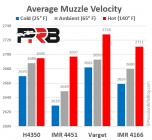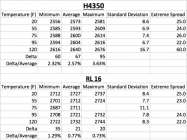urbanrifleman
Site $$ Sponsor
As a former airframe mechanic and having flown aircraft, you're right . . . that's pretty obvious to us. With a gun the air density has very little, if any, effect on actual MV's of a projectile as it doe on the the projectile's velocity somewhere down range. Isn't that why one has to account for the actual MV when measured velocity using a chronograph that's set up 10 or 12 ft from the muzzle (when one wants to be really technical)?
The same air is in the barrel. I guess I would have to respectfully disagree. It does change. Pressure, humidity, etc etc effect the combustion and the forces on the bullet from the very beginning of the process.
There are changes even when the powder has zero temperature instability. Which there are powders now that are essentially near zero. Still velocity changes with weather.
But on the other end, claiming all powders are temp sensitive because velocity changes through the seasons, would also be incorrect. Which some have done.












